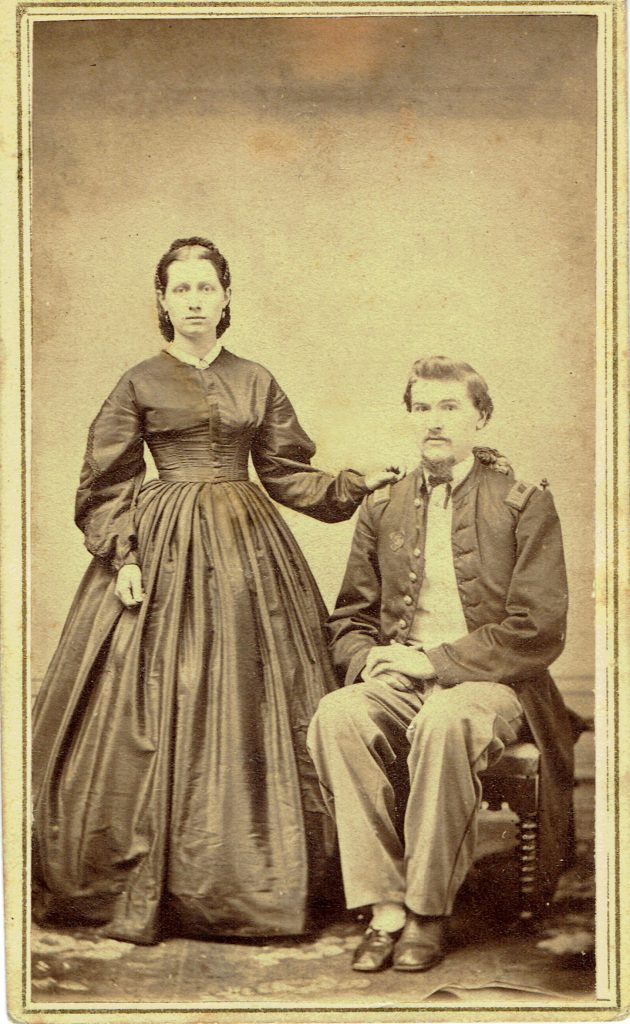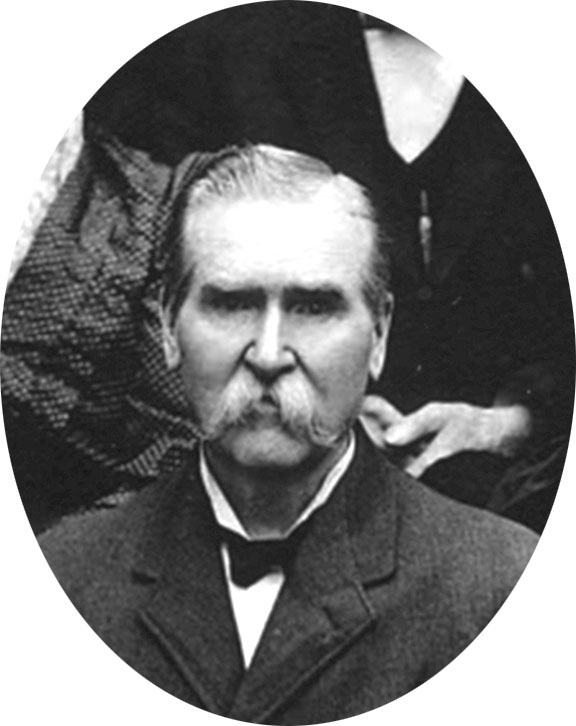Still Troubles Him
I am a compulsive searcher when it comes to newspapers, I just love them. The fact that new pages are continually added, and best of all, pages are re-scanned which sometimes will produce a better image, I can’t get enough. A recent search for “Jacob Cook” in the Appleton, Outagamie County, Wisconsin newspapers told, in his own words, how he was injured during the Civil War while fighting in the Battle of Cold Harbor. For this post, I am including the story of his Civil War years that I published in my book A Snapshot: Jacob Harrison Cook,[1] along with links to actual images from the battlefield, and then adding another layer to the story by including his words published 28 Sep 1899, in the Appleton Weekly Post.[2]
“…Just seven months after the Lady Elgin disaster, April 12, 1861, Civil War broke out between the states. On April 27, 1861, Jacob headed to Taycheedah, Fond du Lac County, Wisconsin to enlist for a term of three years into Company I, 5th Wisconsin Infantry. He was mustered in as a Sergeant July 12, 1861, at Camp Randall, in Madison, Dane County, Wisconsin.[3]
Jacob may have mustered in as a Sergeant, but he did not remain a sergeant for long. In November 1861 he was promoted to 2nd Lieutenant, and then on December 24, 1861, while in the field of Virginia, he was commissioned to 1st Lieutenant…”[4]
“…Jacob continued to prove himself a brave and capable soldier as on May 12, 1863, he was commissioned Captain of Co. I, 5th Wisconsin Infantry, mustering out as Captain J. H. Cook on September 26, 1864, from Annapolis Maryland.”
“His biography included in the Soldiers’ and Citizens’ Album of Biographical Record, tells the tale best in the flowery voice of 1888: ‘Mr. Cook’s first engagement was at Williamsburg and he was one of the detail that made the famous bayonet charge on Fort Magruder, the first in the war. The capture of the battle flag of the 5th North Carolina by the 5th Wisconsin in that action, was one of the first instance in the war when a regimental flag was taken.’ ‘Mr. Cook was in all actions known to history as the Seven Days Battles, being constantly on duty throughout, with the exception of a few hours on Friday, June 27th. He continued unhurt until the last terrific action. At White Oak Swamp, June 30, he was severely injured in his back and sustained a rupture on the left side. [In the act of changing the regiments position ‘on Double quick,’ Jacob ‘sliped on the Root of a Tree and Fell a cross a hedge Hurting his Back and Left Groin.’[5]] [https://civilwarphotos.net/files/images/779.jpg] He was under treatment at Washington Naval Hospital two months and through the winter following he served on court martial duty; he rejoined his regiment near Alexandria in time to participate in the movements at Fredericksburg, where the Wisconsin 5th was deployed to act as reserve. Early in 1863, the ‘Light Division’ was formed, and the regiment incorporated therein, having a well established reputation for reliability in action and emergencies, and the regiments composing that body were, from that day placed where danger was most certain. May 3rd [1863], Mr. Cook participated in the charge on Marye’s Heights, regarded as a hopeless attempt, but which the spirit of the soldiers made successful, and he was again in reserve at Gettysburg. [https://civilwarphotos.net/files/images/381.jpg] In July the regiment was sent to New York to aid in the enforcement of the draft and was stationed on Governor’s Island several months, where the command had artillery drill which served them well in their subsequent experience in action. At Rappahanock Station [Virginia, November 7, 1863] the 5th led the advance and suffered terrific loss. The fight at Spottsylvania [sic] was commenced May 10, 1864, and, on that day Mr. Cook received a blow in the right eye from some unknown missile, which caused great suffering at the time and has resulted in the almost total loss of vision in that eye. He did not leave his post of duty and, two days after, with four others, during the daring movement made by General Hancock re-took and operated a gun which the squad had discovered to be abandoned. They sighted the gun and, afterwards learned that their first fire swept away 42 men in the line of battle. They fired their first six-pounder until all shot in the caisson were exhausted, and three of their number had joined the ‘great majority,’ Captain Cook and Adelbert Norton only remained to relate the incident. In the battle of Cold Harbor in June [1st, 1864], [https://civilwarphotos.net/files/images/329.jpg] Captain Cook was severely wounded, a bullet passing through his right thigh, which still ‘holds fort.’ He passed three days in an army wagon before arriving at White House Landing, and three days after at Alexandria, VA., he first received medical care, six days after being shot. He was in hospital two months, and went home to furlough, returning to Annapolis to be discharged [September 27, 1864].’[6]
The wound that Jacob received in the battle of Cold Harbor took a long time to heal. His hospital record dated July 7, 1864[7] states that there is still much inflammation in the limb, and he was still experiencing fever; he was given a leave of absence of 30 days. As stated above, he ‘went home to furlough.’ On August 2, 1864, his physician in Fond du Lac, Dr. Edmund Delany wrote a letter certifying that Capt. J. H. Cook had been under his ‘care and attendance since July 12, 1864 – that he is still entirely unable for duty; and that he is not yet able to travel without serious inconvenience, and probable injury.’ Dr. Delany did not think it was ‘proper’ for him to travel for at least another 30 days.[8] On August 30, 1864, he was in Madison at Camp Randall for a checkup with Dr. C. B. Pierson, surgeon for the 28th Regiment Wisconsin Volunteer Infantry. Dr. Pierson found that he was ‘still entirely unfit for duty, and also, in my judgement, he is at present unable to travel without serious inconvenience, and probable injury,’[9] he recommended that his leave to be extended an additional 20 days. As previously noted, Jacob never did return to active duty, but traveled to Annapolis to the army hospital to be examined, and on September 27th he was discharged from duty.
During the two months that Jacob was in Wisconsin on furlough, he rekindled his friendship and romance with Anna Eliza Halsted, and on August 26, 1864, they were wed by Justice of the Peace, W. C. Kellogg, in the Town of Friendship, Fond du Lac County, Wisconsin. They were wed in the home, and in the presence of Conner and Kate Healy, brother-in-law and sister of Jacob.

Following his discharge from Co. I, 5th Wisconsin Infantry, Jacob returned to Wisconsin settling in Stockbridge, Calumet County, Wisconsin. Shortly after returning home he filed for an invalid pension, filling out the Declaration for an Invalid Pension form on November 12, 1864, he was just 23 years old. His sisters, Kate Healy and Sarah J. Drake witnessed the document, attesting to the fact that his sole occupation since returning home had been ‘taking care of his leg…”[10][11]
Many years later in September 1899, now 58 years old, Jacob was an elected justice of the peace in Appleton, Outagamie County, Wisconsin, and the Appleton Weekly Post wrote a piece about him, and the bullet that was never removed from his leg, which now “occasionally confines him to the house for several days at a time” due to rheumatism.

“…In response to questions as to how he was wounded, the Captain said that his company, which was supporting a battery, was ordered down a slope about forty rods in front of the guns, who were in hiding in the words. The men were in a kneeling position and had been in that position only a few minutes when the Captain fell forwards on his face. Upon regaining his balance he looked at the men on either side and they in turn looked at him, all realizing that some one had been hit, as they had heard the ‘spat’ of a bullet. It was not until the Captain endeavored to regain his feet that he realized he had been wounded. He felt no pain at the time, and did not for several minutes. The bullet struck his limb about half way between the knee and thigh, and passed at an angle from one side nearly through to the other. He was placed in an army wagon with three others, and on account of being surrounded by rebels was three days in reaching Whitehouse Landing where he was placed on a boat that required three days to reach Alexandria. Here he was placed in a hospital where he received his first medical attention. During the six days his limb had swollen to such an extent that the physicians found it very difficult to remove his clothing. An effort was made to remove the bullet but did not prove successful.”
“Ever since he was wounded he has been compelled to carry a cane, and expects to as long as he lives.”[12]
[1] Fassbender, Susan C., A Snapshot: Jacob Harrison Cook (Appleton, Wisconsin, Self-published, 2006), 4-6.
[2] “Still Troubles Him,” The Appleton Weekly Post, 28 Sep 1899, Thursday, p. 1, col. 4; digital images, Newspapers.com(www.newspapers.com : accessed 11 Oct 2019).
[3] Company Muster-in Roll Card, Jacob H. Cook, Book mark: 9334-D-86. Veteran Record of Jacob H. Cook, National Archives and Records Administration, Veteran Records, Washington DC.
[4] Fassbender, A Snapshot: Jacob Harrison Cook, 4.
[5] General Affidavit for Any Purpose, State of Wisconsin. Jacob H. Cook, Invalid Pension, Sworn testimony of William Billings, Wild Rose, Waushara County, Wisconsin, 9 Mar 1886.
[6] Grand Army Publishing Company, Soldiers’ And Citizens’ Album of Biographical Record, (Chicago, Illinois. Grand Army Publishing Company, 1888), 288-289.
[7] Hospital Patient Record Number 6493, 7 Jul 1864. Veteran Record of Jacob H. Cook, National Archives and Records Administration, Veteran Records, Washington DC.
[8] Edmund Delany, Physician & Surgeon to Whom it may concern, 2 Aug 1864. Veteran Record of Jacob H. Cook, National Archives and Records Administration, Veteran Records, Washington DC.
[9] C. B. Pierson, Surgeon, 38th Regiment Wisconsin Volunteer Infantry, 30 Aug 1864. Veteran Record of Jacob H. Cook, National Archives and Records Administration, Veteran Records, Washington DC.
[10] Fassbender, A Snapshot: Jacob Harrison Cook, 5-6.
[11] Declaration for Invalid Pension, Adjutant General’s Office, Washington DC, 12 Nov 1864. Invalid Pension Record for Jacob H. Cook, National Archives and Records Administration, Invalid Pension Records, Washington DC, Application no. 55279, certificate no: 37916, 19 Nov 1864.
[12] “Still Troubles Him.”